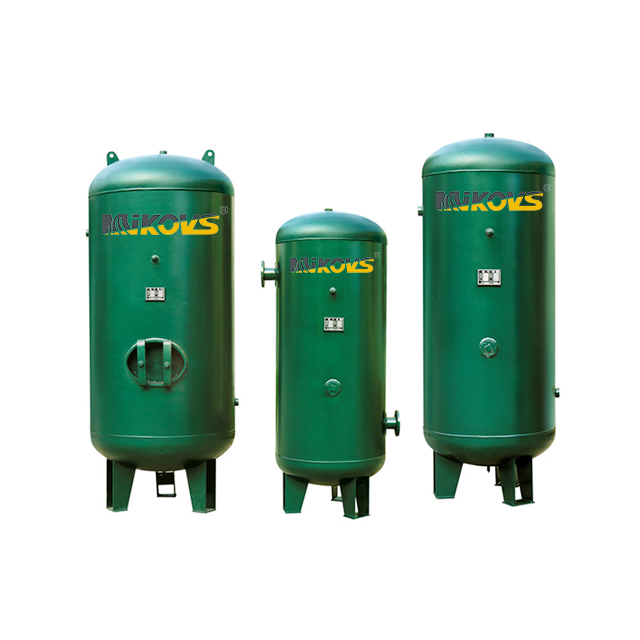Install丨Air storage tank & cold dryer, who comes first?
The correct installation sequence of air storage tank and cold dryer
As a rear configuration of the air compressor, the air storage tank can store a certain amount of air, and the output pressure is relatively stable. At the same time, it can reduce the temperature in the air circuit, remove moisture, dust, impurities, etc. in the air, and also reduce the load of the dryer.
The function of the gas tank
The gas storage tank mainly has the following functions in the field application: buffering, cooling, and water removal.
The main functions of the gas storage tank: buffering, cooling, and water removal. When the air passes through the air storage tank, the high-speed airflow hits the wall of the air storage tank to cause backflow, and the temperature in the air storage tank drops rapidly, so that a large amount of water vapor is liquefied, thereby removing a large amount of water.
The main functions of the cold dryer: first, remove most of the water vapor, and reduce the water content in the compressed air to the required range (that is, the dew point value required by ISO8573.1); second, condense the oil mist and oil vapor in the compressed air, and part of it is separated and discharged by the air-water separator of the cold dryer.
Application of gas storage tank
Air compressor gas enters the air storage tank as soon as it comes out, passes through the air storage tank, filter, and then to the dryer. Because the compressed air of the air compressor is under the action of the air storage tank, when the air passes through the air storage tank, the high-speed airflow hits the wall of the air storage tank to cause backflow, the temperature in the air storage tank drops rapidly, and a large amount of water vapor is liquefied, thereby removing a large amount of water, thereby reducing the load of the cold dryer
The correct pipeline configuration should be: air compressor → air storage tank → primary filter → cold dryer → precision filter → air storage tank → user workshop.
Configuration requirements of the gas storage tank
1. High plasticity and toughness: the material of the cylinder should have good plasticity and toughness, uniform force and reasonable stress distribution. Safety signal holes should be opened on the cylinder to ensure safety.
2. Good corrosion resistance: the inner cylinder is made of materials with good corrosion resistance, and heat treatment for stress relief is carried out, so there is no hydrogen sulfide stress corrosion.
3. Good fatigue resistance: it is best to use finite element elements for fatigue analysis and design to ensure the fatigue resistance of the equipment.
Impact of vibration on gas storage tank
Because under the turbulence of the air flow, the adhesion, release, settlement, and impact of the particles on the inner wall of the ordinary gas storage tank frequently occur, and this situation depends on the gas pressure, the intrinsic density of the particles, the shape and size of the particles, and the operating status of the compressor.
Under the static condition of the gas tank with neither intake nor gas, the particles larger than 1 μm will completely settle to the bottom of the gas tank in less than 16 hours, while the particles of 0.1 μm will take almost two weeks to completely settle. In the dynamic gas condition during operation, the particles in the tank are always suspended, and the particle concentration distribution is uneven. Gravity settling makes the particle concentration on the top of the tank far lower than that at the bottom of the tank, and the diffusion effect makes the particle concentration near the tank wall lower. The impact process mainly occurs at the inlet and outlet of the gas tank. The gas tank itself is the collection and distribution center of particles, and it can also be said to be the source of particle pollution. If such equipment is installed at the end of the station system, various purification methods in the station will be meaningless. When the gas storage tank is installed behind the compressor cooler and in front of various drying and purification equipment, the particles in the tank can be removed by the purification equipment behind regardless of the reason.
in conclusion
Reasonably set up a clean compressed air system, and the air storage tank can make the pneumatic tools work smoothly and normally, so the pressure gas without pulse and fluctuation should be used as the power source. The compressed air storage tank is to overcome the gas pulse and pressure fluctuation caused by the operation of the piston compressor, as well as to separate condensed water and store compressed air.
For screw compressors and centrifugal compressors, the gas storage tank is first to store gas, and secondly to separate condensed water. When there is a large gas load in a short period of time, the gas storage tank can provide auxiliary gas volume supplementary supply, so that the pressure drop in the pipeline network does not fluctuate greatly, so that the compressor start-up frequency or load adjustment frequency is always within the allowable and reasonable range. Therefore, the gas storage tank is an important part of the process system of the station.
For the air storage tank of the compressed air system, it should be installed after the compressor (cooler), degreaser, and before freeze-drying, and should not be placed at the end of the station building piping system like ordinary compressed air systems. Of course, if conditions permit, adding an energy storage tank at the end is the best choice.
Disclaimer: This article is reproduced from the Internet. The content of the article is for learning and communication purposes only. Air Compressor Network remains neutral to the views in the article. The copyright of the article belongs to the original author and the platform. If there is any infringement, please contact to delete



_01-56.jpg)